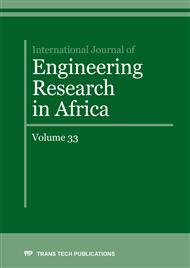[1]
M. E. El-Hawary, J. K. Landrigan. Optimum operation of fixed-head hydro-thermal electric power systems: Powell's Hybrid Method Versus Newton-Raphson Method. IEEE Transactions on Power Apparatus and Systems, on. 101, no. 3, (1982): 547-554.
DOI: 10.1109/tpas.1982.317267
Google Scholar
[2]
Berry, G. & Curien, P. L. Sequetial algorithms on concrete data structures. Theor. Comput. Sci. 20, (1982): 265–321.
Google Scholar
[3]
Yoshihiro tanaka, Masao fukushima and Toshihide ibaraki. A comparative study of several semi-infinite nonlinear programming algorithms. A. Theory and Methodology 36, (1988): 92–100.
DOI: 10.1016/0377-2217(88)90010-0
Google Scholar
[4]
Gaing, Z. -L. Particle swarm optimization to solving the economic dispatch considering the generator constraints. IEEE Trans. Power Syst. 18, (2003): 1187-1195.
DOI: 10.1109/tpwrs.2003.814889
Google Scholar
[5]
El Ela, A. A., Abido, M. Spea, S. Optimal power flow using differential evolution algorithm. Electr. Power Syst. 80, (2010): 878-885.
DOI: 10.1016/j.epsr.2009.12.018
Google Scholar
[6]
Bachir Bentouati. Lakhdar Chaib and Saliha Chettih. Optimal Power Flow using the Moth Flam Optimizer: A case study of the Algerian power system. Indonesian Journal of Electrical Engineering and Computer Science.; (2016): 1: 3.
DOI: 10.11591/ijeecs.v1.i3.pp431-445
Google Scholar
[7]
Bouchekara, H. R. E. H., Chaib, A. E., Abido, M. A. & El-sehiemy, R. A. Optimal power flow using an Improved Colliding Bodies Optimization algorithm. Appl. Soft Comput. J, 42 (2016): 119–131.
DOI: 10.1016/j.asoc.2016.01.041
Google Scholar
[8]
Bachir Bentouati, Saliha Chettih, Pradeep . Jangir and Indrajit N. Trivedi. A solution to the optimal power flow using multi-verse optimizer J. Electrical Systems 12-4 pp. (2016): 716-733.
Google Scholar
[9]
Yang XS, Nature-inspired metaheuristic algorithms, 2nd Ed., Luniver Press, Bristol (2010).
Google Scholar
[10]
Yang XS, Engineering optimization: an introduction with metaheuristic applications. Wiley, London (2010).
Google Scholar
[11]
Deb, X. Y. S. Cuckoo search: recent advances and applications. (2013). doi: 10. 1007/s00521-013-1367-1.
Google Scholar
[12]
Wang, G., Deb, S., Gandomi, A. H., Zhang, Z. & Alavi, A. H. Chaotic cuckoo search. Soft Comput. (2015). doi: 10. 1007/s00500-015-1726-1.
DOI: 10.1007/s00500-015-1726-1
Google Scholar
[13]
Park, J. -B., Lee, K. -S., Shin, J. -R., A particle swarm optimization for economic dispatch with non-smooth cost functions, Power Systems, IEEE Transactions on, vol 20, 1, ( 2005) 34-42.
DOI: 10.1109/tpwrs.2004.831275
Google Scholar
[14]
Bouchekara, et all , R. A. Optimal power flow using an Improved Colliding Bodies Optimization algorithm. Appl. Soft Comput. J., vol 42, (2016): 119–131.
DOI: 10.1016/j.asoc.2016.01.041
Google Scholar
[15]
S. Duman, U. Guvenc, Y. Sonmez & N. Yorukeren, Optimal power flow using gravitational search algorithm, Energy Conversion and Management, 59, (2012): 86–95.
DOI: 10.1109/inista.2012.6246993
Google Scholar
[16]
M. Joorabian & E. Afzalan, Optimal power flow under both normal and contingent operation conditions using the hybrid fuzzy particle swarm optimisation and Nelder–Mead algorithm (HFPSO–NM), Applied Soft Computing, 14, ( 2014): 623–633.
DOI: 10.1016/j.asoc.2013.09.015
Google Scholar
[17]
Ahmed Salhi, Djemai Naimi , Tarek Bouktir Optimal power flow resolution using artificial bee colony algorithm based grenade explosion method, J. Electrical Systems 6-4 (2016): 734-756.
Google Scholar
[18]
Rezaei, A.M., and Karami, A., Artificial bee colony algorithm for solving muli-objective optimal power flow problem, Electr. Power Energy Syst., Vol. 53, (2013): 219–230.
DOI: 10.1016/j.ijepes.2013.04.021
Google Scholar
[19]
R. Roy & H.T. Jadhav, Optimal power flow solution of power system incorporating stochastic wind power using Gbest guided artificial bee colony algorithm, Electrical Power and Energy Systems, 64, ( 2015): 562–578.
DOI: 10.1016/j.ijepes.2014.07.010
Google Scholar
[20]
Sayah S, Zehar K. Modified differential evolution algorithm for optimal power flow with non-smooth cost functions. Energy Convers Manag; 49 (2008): 3036–42.
DOI: 10.1016/j.enconman.2008.06.014
Google Scholar
[21]
A. Ramesh Kumar & L. Premalatha, Optimal power flow for a deregulated power system using adaptive real coded biogeography-based optimization, Electrical Power and Energy Systems, 73, (2015): 393–399.
DOI: 10.1016/j.ijepes.2015.05.011
Google Scholar
[22]
Ghasemi,M., Ghavidel, S., Rahmani, S., Roosta, A., and Falah, H., A novel hybrid algorithm of imperialist competitive algorithm and teaching learning algorithm for optimal power flow problem with non-smooth cost function, Eng. Appl. Art. Intellig., Vol. 29, (2014).
DOI: 10.1016/j.engappai.2013.11.003
Google Scholar
[23]
Niknam, T., Narimani, M. R., and Azizipanah-Abarghooee, R., A new hybrid algorithm for optimal power flow considering prohibited zones and valve point effect, Energy Conv. Manage., Vol. 58, (2012): 197–206.
DOI: 10.1016/j.enconman.2012.01.017
Google Scholar
[24]
Basu, M., Multi-objective optimal power flow with FACTS , Energy Convers. Manag., Vol. 52, pp. ( 2011): 903–910.
DOI: 10.1016/j.enconman.2010.08.017
Google Scholar
[25]
Bouchekara, H. R. E. H., Abido, M. A., and Boucherma, M., Optimal power flow using teaching–learning-based optimization technique, Electr. Power Syst. Res., Vol. 114, (2014): 49–59.
DOI: 10.1016/j.epsr.2014.03.032
Google Scholar
[26]
Christy, A. A., and Vimal Raj, P. A. D., Adaptive biogeography based predator–prey optimization technique for optimal power flow, Electr. Power Energy Syst., Vol. 62, (2014): 344–352.
DOI: 10.1016/j.ijepes.2014.04.054
Google Scholar
[27]
A. Bhattacharya & PK. Chattopadhyay, Application of biogeography-based optimisation to solve different optimal power flow problems, IET Generation, Transmission and Distribution, on 5 no 1, ( 2011): 70–80.
DOI: 10.1049/iet-gtd.2010.0237
Google Scholar
[28]
Abido, M. A., Optimal power flow using particle swarm optimization, Electr. Power Energy Syst., on 24, (2002): 563–571.
DOI: 10.1016/s0142-0615(01)00067-9
Google Scholar
[29]
Roy, P. K., and Paul, C., Optimal power flow using krill herd algorithm, Int. Trans. Electr. Energ. Syst., ( 2014) DOI: 10. 1002/etep. 1888.
DOI: 10.1002/etep.1888
Google Scholar
[30]
A. A. Abou El Elaa, M.A. Abido & S.R. Spea, Optimal power flow using differential evolution algorithm, Electric Power Systems Research, 80, (2010): 878–885.
DOI: 10.1016/j.epsr.2009.12.018
Google Scholar
[31]
M. Rezaei Adaryani & A. Karami, Artificial bee colony algorithm for solving multi-objective optimal power flow problem, Electrical Power and Energy Systems, on 53, 2 (2013): 19–230.
DOI: 10.1016/j.ijepes.2013.04.021
Google Scholar
[32]
Sailaja, K. M., and Maheswarapu, S., Enhanced genetic algorithm based computation technique for multi-objective optimal power flow, Electr. Power Energy Syst., no. 32, (2010): 736–742.
DOI: 10.1016/j.ijepes.2010.01.010
Google Scholar


